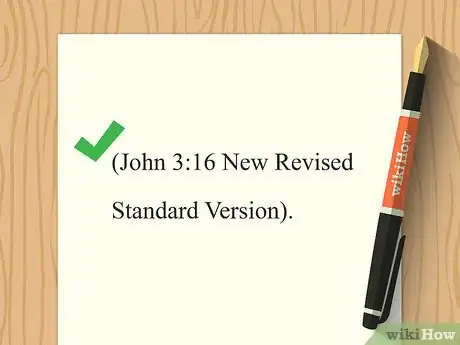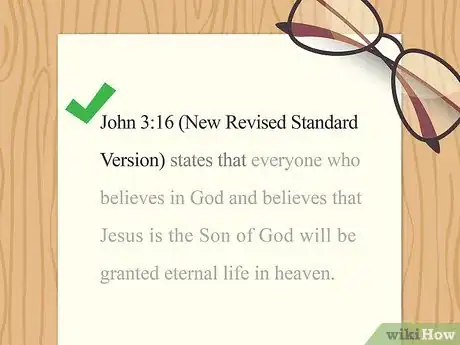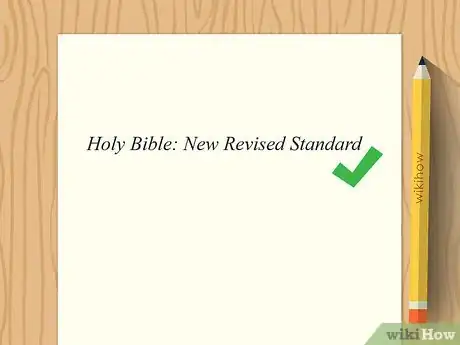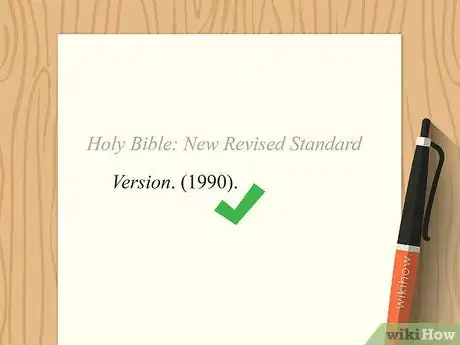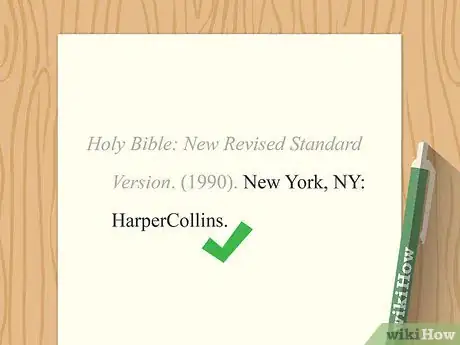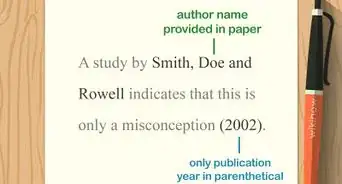This article was co-authored by wikiHow staff writer, Jennifer Mueller, JD. Jennifer Mueller is a wikiHow Content Creator. She specializes in reviewing, fact-checking, and evaluating wikiHow's content to ensure thoroughness and accuracy. Jennifer holds a JD from Indiana University Maurer School of Law in 2006.
This article has been viewed 48,663 times.
Learn more...
Even in an academic research paper, you may find that you want to cite the Bible as a source. As with any source, you have to cite the Bible if you paraphrase or quote it in your text. The American Psychological Association (APA) Publication Manual does not require a reference list entry for the Bible – only an in-text citation. However, your instructor or advisor may want publication information in your reference list. If you include a reference list entry, use the APA format for a book with no identified author.
Steps
In-Text Citation
-
1List the book title, chapter, and verse in your parenthetical citation. At the end of the sentence where you've paraphrased or quoted the Bible, place a parenthetical citation inside the closing punctuation. Start by typing the title of the book of the Bible, then type the chapter and verse. Separate the chapter and verse with a colon. If your quote or paraphrase covers multiple verses, use a hyphen between the first and last verse of the range.[1]
- Example: (John 3:16
- Abbreviate longer book names in your parenthetical citation. A handy table of abbreviations used in APA style can be found at https://www.apu.edu/live_data/files/288/citing_the_bible.pdf.
-
2Add the name of the version you used. After the chapter and verse, type the full name of the version of the Bible you used. Do not include any intervening punctuation between the verse and the name of the version. Place the sentence's closing punctuation outside the closing parenthesis.[2]
- Example: (John 3:16 New Revised Standard Version).
APA In-Text Bible Citation Format
(Book Chapter:Verse Version).
Advertisement -
3Omit the version in subsequent citations unless you switch versions. After your first parenthetical citation, you don't have to include the name of the version you used as long as you continue to use the same version. If you use different versions, however, include the name of the new version you used in the parenthetical citation. If you switch back, you would add the version again.[3]
- For example, if you were comparing the language used in different translations, you would need to include each of the different versions in the parenthetical citations.
-
4Incorporate the citation information into your text. A parenthetical citation is not required at all if you include all the information that would normally be in the parenthetical citation in the body text of your paper. If you include the chapter and verse but not the name of the version of the Bible you used, put the name of the version in parentheses immediately after the chapter and verse in your first citation to that version.[4]
- For example, you might write "John 3:16 (New Revised Standard Version) states that everyone who believes in God and believes that Jesus is the Son of God will be granted eternal life in heaven."
Reference List Entry
-
1Ask your instructor or advisor if a reference list entry is required. APA doesn't require a reference list entry for commonly known classical or religious works such as the Bible. However, your instructor may want you to include it anyway. If they do, create a reference list entry that follows the format for a book with no identified author.[5]
- If you're citing supplementary material in the Bible, such as an introduction or study notes, you would typically include a reference list entry citing that portion as though it were an article or entry in a reference book, including the name of the author.
-
2Start your reference list entry with the title. Provide the full title of the Bible in italics as listed on the title page. Use title-case, capitalizing all nouns, pronouns, verbs, adverbs, and adjectives. Place a colon after the title and include the name of the version as a "subtitle" after the title. Place a period at the end of the name of the version.[6]
- Example: Holy Bible: New Revised Standard Version.
-
3Add the year of publication in parentheses. After the title of the book, list the year that particular version of the book was published. You should be able to find this information on the copyright page of the specific Bible you used. Place a period outside the closing parenthesis.[7]
- Example: Holy Bible: New Revised Standard Version. (1990).
-
4Close with the place of publication and name of the publisher. For US publishers, type the city and state where the publisher is located, separated by a comma. Abbreviate state names. If the version you used was published outside the US, use the name of the city and the name of the country as the location. Place a colon after the location, then add the name of the publisher. Place a period after the name of the publisher.[8]
- Example: Holy Bible: New Revised Standard Version. (1990). New York, NY: HarperCollins.
APA Reference List Format
Holy Bible: Name of Version. (Year). City, State: Publisher.
References
- ↑ https://www.messiah.edu/download/downloads/id/1647/bible_cite.pdf
- ↑ https://www.messiah.edu/download/downloads/id/1647/bible_cite.pdf
- ↑ https://hbl.gcc.libguides.com/c.php?g=339562&p=2286667
- ↑ https://www.messiah.edu/download/downloads/id/1647/bible_cite.pdf
- ↑ https://morlingcollege.libguides.com/apareferencing/bible
- ↑ https://libguides.up.edu/apa/biblical_sources
- ↑ https://libguides.up.edu/apa/biblical_sources
- ↑ https://libguides.up.edu/apa/biblical_sources

